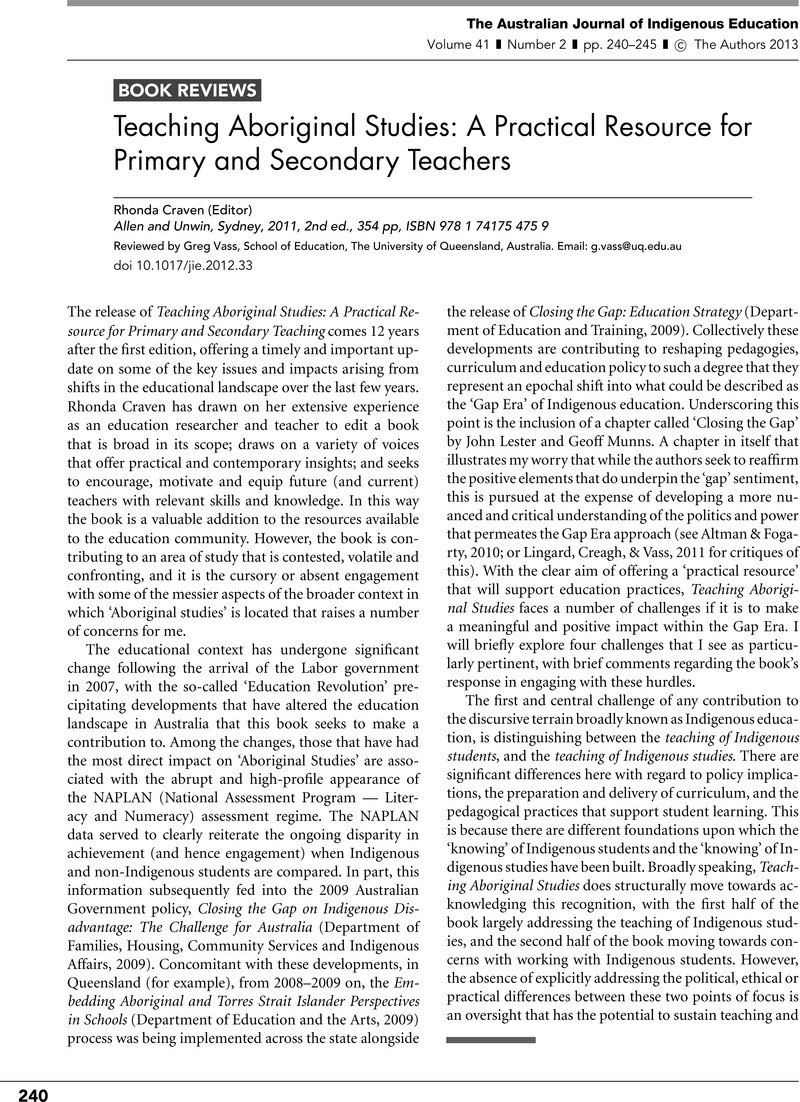No CrossRef data available.
Article contents
Teaching Aboriginal Studies: A Practical Resource for Primary and Secondary TeachersRhonda Craven (Editor) Allen and Unwin, Sydney, 2011, 2nd ed., 354 pp, ISBN 978 1 74175 475 9
Review products
Teaching Aboriginal Studies: A Practical Resource for Primary and Secondary Teachers Rhonda Craven (Editor) Allen and Unwin, Sydney, 2011, 2nd ed., 354 pp, ISBN 978 1 74175 475 9
Published online by Cambridge University Press: 22 January 2013
Abstract
An abstract is not available for this content so a preview has been provided. Please use the Get access link above for information on how to access this content.

Information
- Type
- Book Review
- Information
- The Australian Journal of Indigenous Education , Volume 41 , Issue 2 , December 2012 , pp. 240 - 243
- Copyright
- Copyright © The Authors 2013
References
Altman, J., & Fogarty, B. (2010). Indigenous Australians as ‘No Gaps’ subjects: Education and development in remote Australia. In Snyder, I. & Niewenhuysen, J. (Eds.), Closing the gap in education?: Improving outcomes in southern world societies (pp. 109–128). Melbourne, Australia: Monash University Publishing.Google Scholar
Aveling, N. (2004). Critical whiteness studies and the challenges of learning to be a ‘White Ally’. borderlands ejournal. Retrieved from http://www.borderlands.net.au/issues/index.htmlGoogle Scholar
Aveling, N. (2006). Hacking at our very roots: rearticulating white racial identity within the context of teacher education. Race, Ethnicity and Education, 9 (3), 261–274.CrossRefGoogle Scholar
Department of Education and Training. (2009). Closing the gap: Education strategy. Brisbane, Australia: Queensland Government.Google Scholar
Department of Education and the Arts. (2009). Embedding Aboriginal and Torres Strait Islander perspectives in schools: P-12 school guidelines for administrators and educators — a building block in Partners for Success. Brisbane, Australia: Queensland Government.Google Scholar
Department of Families, Housing, Community Services and Indigenous Affairs. (2009). Closing the gap on Indigenous disadvantage: The challenge for Australia. Retrieved from http://www.fahcsia.gov.au/indigenous/closing_the_gap/default.htmGoogle Scholar
Galman, S., Pica-Smith, C., & Rosenberger, C. (2010). Aggressive and tender navigations: Teacher educators confront Whiteness in their practice. Journal of Teacher Education, 61 (3), 225–236.CrossRefGoogle Scholar
Hickling-Hudson, A. (2003). The training of teachers for cultural diversity and social justice. In Hernes, G., Martin, M. & Zadra, E. (Eds.), Planning for diversity: Education in multi-ethnic and multicultural societies, Policy Forum 17 (pp. 279–306). Paris: International Institute for Educational Planning, UNESCO.Google Scholar
Lingard, B., Creagh, S., & Vass, G. (2011). Education policy as numbers: Data categories and two Australian cases of misrecognition. Journal of Education Policy, 27 (3): 315–333.CrossRefGoogle Scholar
Nakata, M. (2007). The cultural interface. The Australian Journal of Indigenous Education, 36, 7–14.CrossRefGoogle Scholar
Nicholls, C., Crowley, V., & Watt, R. (1998). Black and white educational theorizing: An evaluation of the impact of Aboriginal learning styles theory on Australian Aboriginal education. Ngoonjook, 32–59.Google Scholar
O'Dowd, M. (2010). ‘Ethical Positioning’: A strategy in overcoming student resistance and fostering engagement in teaching Aboriginal history as a compulsory subject to pre-service primary education students. Education in Rural Australia, 20 (1), 29–42.CrossRefGoogle Scholar
Phillips, J., & Whatman, S. (2007). Decolonising preservice teacher education — Reform at many cultural interfaces. In Proceedings of The World of Educational Quality AERA Annual Meeting. Chicago, IL: The World of Educational Quality.Google Scholar
Picower, B. (2009). The unexamined whiteness of teaching: How white teachers maintain and enact dominant racial ideologies. Race, Ethnicity and Education, 12 (2), 197–215.CrossRefGoogle Scholar
Taylor, E. (2009). The foundations of critical race theory in education: An introduction. In Taylor, E., Gillborn, D., & Ladson-Billings, G. (Eds.), The foundations of critical race theory in education (pp. 1–13). New York: Routledge.Google Scholar
Wadham, B., Pudsey, J. & Boyd, R. (2007). ‘We grew here . . . you flew here’: Race, nation and education. In Wadham, B., Pudsey, J., & Boyd, R.. (Eds.), Culture and Education (pp. 167–211). Kuala Lumpur, Malaysia: Pearson Education.Google Scholar

